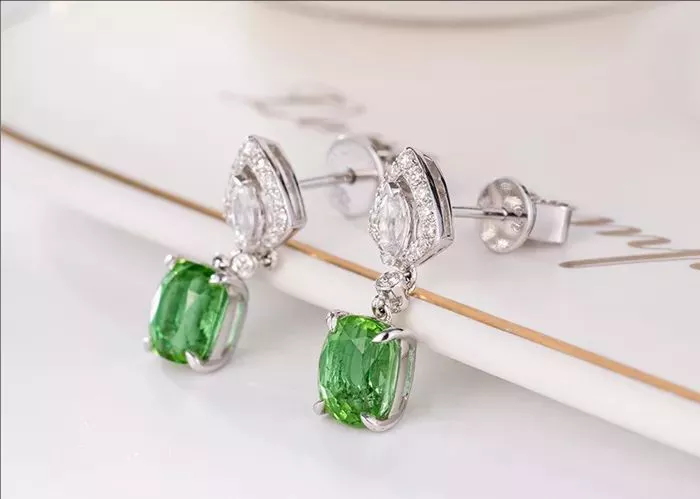Green tourmaline is a beautiful and valuable gemstone, popular in the jewelry industry for its vibrant color and versatility. As a jeweler, knowing how to price green tourmaline correctly is essential for running a successful business. The value of green tourmaline depends on several factors, including color, clarity, cut, carat weight, and market demand. This guide will explain how to charge green tourmaline in a way that is fair to both the seller and the buyer.
Understanding Green Tourmaline
Before setting a price, it is important to understand what green tourmaline is and what makes it valuable. Tourmaline is a mineral that comes in many colors, but green tourmaline is one of the most sought-after varieties. The green color comes from traces of iron, chromium, or vanadium in the crystal structure. Some green tourmalines have a deep, rich color, while others are lighter or have secondary hues like blue or yellow.
The most valuable green tourmalines are those with a pure, intense green color, similar to emerald. Stones with high clarity and a well-proportioned cut also command higher prices. Larger stones are rarer, so carat weight significantly affects pricing. Additionally, some green tourmalines exhibit special optical effects, such as color-changing or cat’s eye effects, which can increase their value.
Factors That Affect the Price of Green Tourmaline
Several key factors determine how much green tourmaline is worth. Understanding these factors will help you set a fair and competitive price.
Color – The most important factor in pricing green tourmaline is its color. The finest stones have a vivid, saturated green hue without any brown or gray undertones. Darker greens are common, but if the stone is too dark, it may appear black in certain lighting, reducing its value. Bright, medium-toned greens are the most desirable.
Clarity – Like most gemstones, green tourmaline should be as free from inclusions as possible. However, some inclusions are acceptable if they do not affect the stone’s durability or beauty. Eye-clean stones (those with no visible inclusions to the naked eye) are more valuable than heavily included ones.
Cut – A well-cut green tourmaline will showcase its color and brilliance. Poorly cut stones may look dull or have uneven color distribution. Skilled cutting can enhance the stone’s natural beauty, so precision-cut tourmalines are worth more.
Carat Weight – Larger green tourmalines are rarer and more expensive per carat than smaller ones. Prices do not always increase linearly with size; a 5-carat stone may cost significantly more per carat than a 1-carat stone of the same quality.
Origin – Some sources of green tourmaline are more prestigious than others. For example, tourmalines from Brazil, Nigeria, and Mozambique are highly regarded. Stones from certain mines may command higher prices due to their reputation for quality.
Treatments – Many green tourmalines are heat-treated to improve their color. This is a common and accepted practice, but untreated stones are often more valuable if their color is naturally vibrant. Always disclose any treatments to buyers.
How to Calculate the Price of Green Tourmaline
Now that you understand the factors affecting value, the next step is learning how to calculate the price. Jewelers typically price green tourmaline per carat, with the final price depending on the stone’s quality.
First, assess the stone’s color, clarity, cut, and carat weight. Compare it to similar stones in the market to get an idea of the current price range. Online gemstone dealers, auction results, and trade shows can provide useful pricing references.
Next, determine your base price per carat based on quality. For example:
- Low-quality green tourmaline (pale color, visible inclusions, poor cut): 20−50 per carat
- Medium-quality (nice green color, minor inclusions, decent cut): 50−200 per carat
- High-quality (vivid green, eye-clean, excellent cut): 200−800 per carat
- Top-quality (rare intense green, flawless, precision cut): 800−3,000+ per carat
Multiply the per-carat price by the stone’s weight to get the base price. Then, adjust for factors like origin (premium for certain mines), treatments (discount if heavily treated), and market demand.
Setting a Retail Price
Once you have the base price, you need to determine the retail price. Jewelers typically apply a markup to cover business costs and profit. The markup depends on your business model, but common ranges are:
- Wholesale: 10% – 30% markup
- Retail: 50% – 200% markup
Additional Costs to Consider
When pricing green tourmaline, remember to factor in additional costs such as:
- Certification – Gemological reports (e.g., GIA, AGL) add credibility but cost extra.
- Setting and Labor – If you’re selling mounted tourmaline, include the cost of metal and labor.
- Overhead – Rent, utilities, marketing, and staff salaries affect your final price.
- Market Trends – Prices fluctuate based on supply and demand. Stay updated on industry trends.
Selling Strategies for Green Tourmaline
To maximize profits, use smart selling strategies:
- Highlight Unique Features – If the stone has exceptional color or rarity, emphasize this in marketing.
- Offer Custom Designs – Customers may pay more for custom jewelry featuring green tourmaline.
- Educate Buyers – Explain why high-quality tourmaline is worth the price.
- Bundle Deals – Pair tourmaline with complementary gems to increase sales.
Conclusion
Pricing green tourmaline correctly requires knowledge of gemstone quality, market trends, and business costs. By evaluating color, clarity, cut, and carat weight, you can set a fair base price. Adjust for origin, treatments, and demand, then apply a suitable markup. Keep overhead and certification costs in mind, and use effective selling strategies to attract buyers. With this approach, you can confidently charge green tourmaline at a price that reflects its true value while ensuring a profitable jewelry business.
Related topics:
- Who Should Wear Green Tourmaline: A Detailed Guide
- Who Should Wear Green Tourmaline: A Comprehensive Guide
- Who Should Wear Green Tourmaline?


